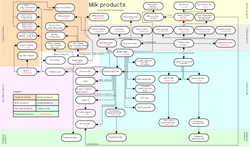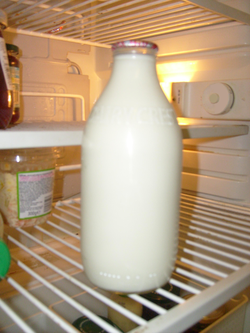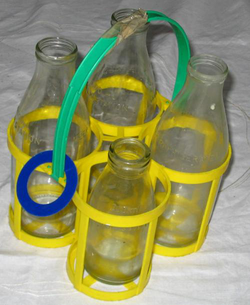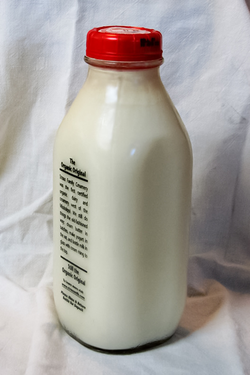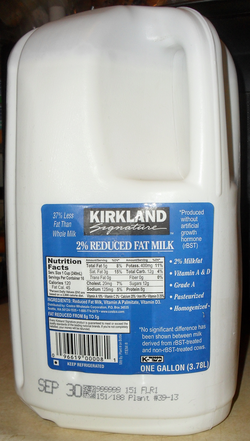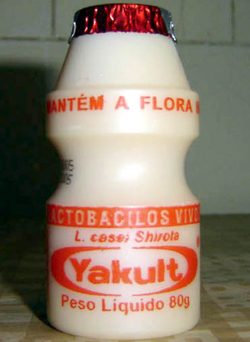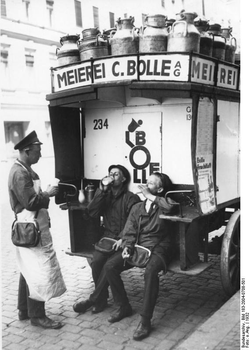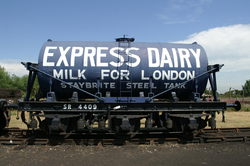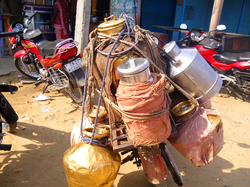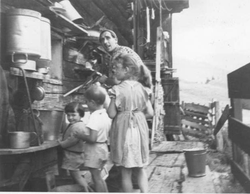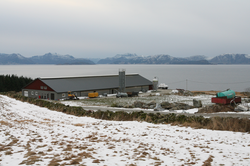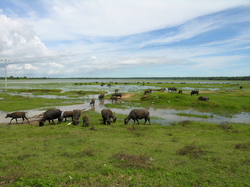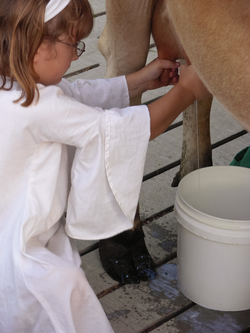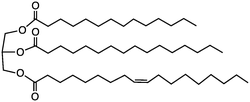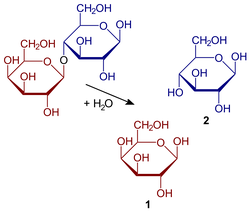Milk
Milk
| Nutritional value per 100 g (3.5 oz) | |
|---|---|
| Energy | 252 kJ (60 kcal) |
| Sugars | 5.26 g |
| Saturated | 1.865 g |
| Monounsaturated | 0.812 g |
| Polyunsaturated | 0.195 g |
| Tryptophan | 0.075 g |
| Threonine | 0.143 g |
| Isoleucine | 0.165 g |
| Leucine | 0.265 g |
| Lysine | 0.140 g |
| Methionine | 0.075 g |
| Cystine | 0.017 g |
| Phenylalanine | 0.147 g |
| Tyrosine | 0.152 g |
| Valine | 0.192 g |
| Arginine | 0.075 g |
| Histidine | 0.075 g |
| Alanine | 0.103 g |
| Aspartic acid | 0.237 g |
| Glutamic acid | 0.648 g |
| Glycine | 0.075 g |
| Proline | 0.342 g |
| Serine | 0.107 g |
| Vitamins | |
| Vitamin A equiv. | |
| Thiamine (B1) | |
| Riboflavin (B2) | |
| Vitamin B12 | |
| Choline | |
| Vitamin D | |
| Minerals | |
| Calcium | |
| Magnesium | |
| Potassium | |
| Sodium | |
| Other constituents | |
| Water | 88.32 g |
| Percentages are roughly approximated usingUS recommendationsfor adults. | |
Milk is a white liquid produced by the mammary glands of mammals. It is the primary source of nutrition for infant mammals (including humans who breastfeed) before they are able to digest other types of food. Early-lactation milk contains colostrum, which carries the mother's antibodies to its young and can reduce the risk of many diseases. It contains many other nutrients including protein and lactose.
As an agricultural product, milk is extracted from non-human mammals during or soon after pregnancy. Dairy farms produced about 730 million tonnes of milk in 2011, from 260 million dairy cows. India is the world's largest producer of milk, and is the leading exporter of skimmed milk powder, yet it exports few other milk products. The ever increasing rise in domestic demand for dairy products and a large demand-supply gap could lead to India being a net importer of dairy products in the future. The United States, India, China and Brazil are the world's largest exporters of milk and milk products. China and Russia were the world's largest importers of milk and milk products until 2016 when both countries became self-sufficient, contributing to a worldwide glut of milk.
Throughout the world, more than six billion people consume milk and milk products.
Over 750 million people live in dairy farming households.
| Nutritional value per 100 g (3.5 oz) | |
|---|---|
| Energy | 252 kJ (60 kcal) |
| Sugars | 5.26 g |
| Saturated | 1.865 g |
| Monounsaturated | 0.812 g |
| Polyunsaturated | 0.195 g |
| Tryptophan | 0.075 g |
| Threonine | 0.143 g |
| Isoleucine | 0.165 g |
| Leucine | 0.265 g |
| Lysine | 0.140 g |
| Methionine | 0.075 g |
| Cystine | 0.017 g |
| Phenylalanine | 0.147 g |
| Tyrosine | 0.152 g |
| Valine | 0.192 g |
| Arginine | 0.075 g |
| Histidine | 0.075 g |
| Alanine | 0.103 g |
| Aspartic acid | 0.237 g |
| Glutamic acid | 0.648 g |
| Glycine | 0.075 g |
| Proline | 0.342 g |
| Serine | 0.107 g |
| Vitamins | |
| Vitamin A equiv. | |
| Thiamine (B1) | |
| Riboflavin (B2) | |
| Vitamin B12 | |
| Choline | |
| Vitamin D | |
| Minerals | |
| Calcium | |
| Magnesium | |
| Potassium | |
| Sodium | |
| Other constituents | |
| Water | 88.32 g |
| Percentages are roughly approximated usingUS recommendationsfor adults. | |
Etymology
The term "milk" comes from "Old English meoluc (West Saxon), milc (Anglian), from Proto-Germanic *meluks "milk" (source also of Old Norse mjolk, Old Frisian melok, Old Saxon miluk, Dutch melk, Old High German miluh, German Milch, Gothic miluks)".
Types of consumption
Milk consumption occurs in two distinct overall types: a natural source of nutrition for all infant mammals and a food product obtained from other mammals for consumption by humans of all ages.
Nutrition for infant mammals
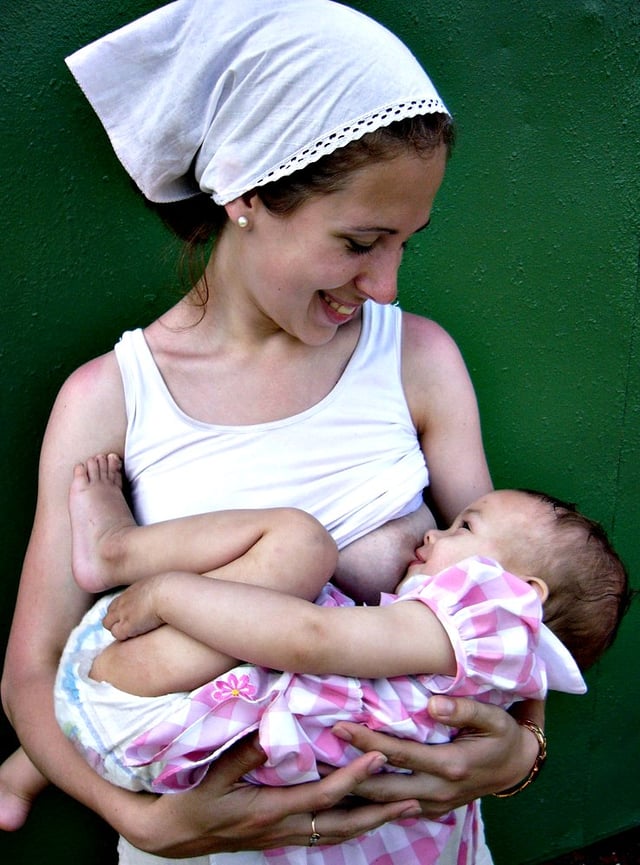
Breastfeeding to provide a mother's milk
In almost all mammals, milk is fed to infants through breastfeeding, either directly or by expressing the milk to be stored and consumed later. The early milk from mammals is called colostrum. Colostrum contains antibodies that provide protection to the newborn baby as well as nutrients and growth factors. The makeup of the colostrum and the period of secretion varies from species to species.
For humans, the World Health Organization recommends exclusive breastfeeding for six months and breastfeeding in addition to other food for at least two years. In some cultures it is common to breastfeed children for three to five years, and the period may be longer.
Fresh goats' milk is sometimes substituted for breast milk, which introduces the risk of the child developing electrolyte imbalances, metabolic acidosis, megaloblastic anemia, and a host of allergic reactions.
Food product for humans
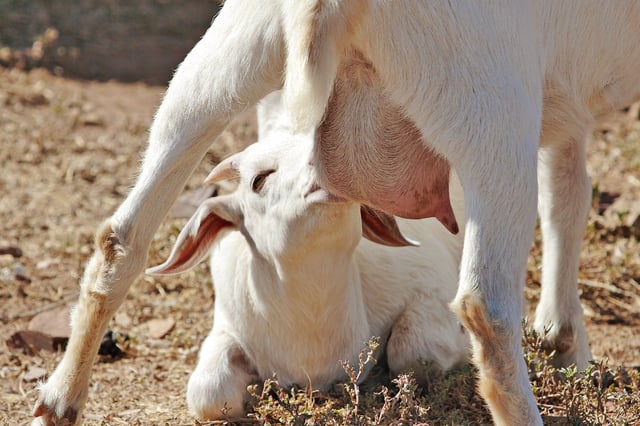
A goat kid feeding on its mother's milk
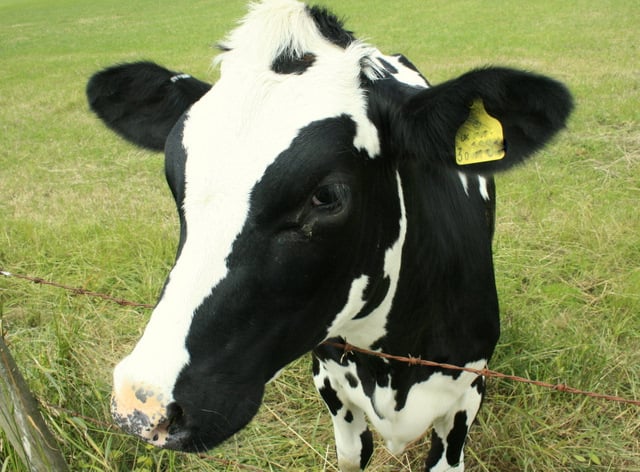
The Holstein Friesian cattle is the dominant breed in industrialized dairy farms today
In many cultures, especially in the West, humans continue to consume milk beyond infancy, using the milk of other mammals (especially cattle, goats and sheep) as a food product.
Initially, the ability to digest milk was limited to children as adults did not produce lactase, an enzyme necessary for digesting the lactose in milk. People therefore converted milk to curd, cheese and other products to reduce the levels of lactose. Thousands of years ago, a chance mutation spread in human populations in Europe that enabled the production of lactase in adulthood. This mutation allowed milk to be used as a new source of nutrition which could sustain populations when other food sources failed. People process milk into a variety of products such as cream, butter, yogurt, kefir, ice cream, and cheese. Modern industrial processes use milk to produce casein, whey protein, lactose, condensed milk, powdered milk, and many other food-additives and industrial products.
Whole milk, butter and cream have high levels of saturated fat. The sugar lactose is found only in milk, forsythia flowers, and a few tropical shrubs. The enzyme needed to digest lactose, lactase, reaches its highest levels in the human small intestine after birth and then begins a slow decline unless milk is consumed regularly. Those groups who do continue to tolerate milk, however, often have exercised great creativity in using the milk of domesticated ungulates, not only of cattle, but also sheep, goats, yaks, water buffalo, horses, reindeer and camels. India is the largest producer and consumer of cattle and buffalo milk in the world.
| Country | Milk (liters) | Cheese (kg) | Butter (kg) |
|---|---|---|---|
Terminology
In food use, the term milk is defined under Codex Alimentarius standards as: "the normal mammary secretion of milking animals obtained from one or more milkings without either addition to it or extraction from it, intended for consumption as liquid milk or for further processing." This definition thereby precludes non-animal products which may resemble milk in color and texture (milk substitutes) such as soy milk, rice milk, almond milk, and coconut milk. The correct name for such products are 'soy beverage', 'rice beverage', etc.
Dairy relates to milk and milk production, e.g. dairy products.
In addition, a substance secreted by pigeons to feed their young is called "crop milk" and bears some resemblance to mammalian milk, although it is not consumed as a milk substitute.
Evolution of lactation
The mammary gland is thought to have derived from apocrine skin glands. It has been suggested that the original function of lactation (milk production) was keeping eggs moist. Much of the argument is based on monotremes (egg-laying mammals). The original adaptive significance of milk secretions may have been nutrition or immunological protection. This secretion gradually became more copious and accrued nutritional complexity over evolutionary time.
Tritylodontid cynodonts seem to have displayed lactation, based on their dental replacement patterns.
History
Humans first learned to consume the milk of other mammals regularly following the domestication of animals during the Neolithic Revolution or the development of agriculture. This development occurred independently in several global locations from as early as 9000–7000 BC in Mesopotamia to 3500–3000 BC in the Americas. People first domesticated the most important dairy animals—cattle, sheep and goats—in Southwest Asia, although domestic cattle had been independently derived from wild aurochs populations several times since. Initially animals were kept for meat, and archaeologist Andrew Sherratt has suggested that dairying, along with the exploitation of domestic animals for hair and labor, began much later in a separate secondary products revolution in the fourth millennium BC. Sherratt's model is not supported by recent findings, based on the analysis of lipid residue in prehistoric pottery, that shows that dairying was practiced in the early phases of agriculture in Southwest Asia, by at least the seventh millennium BC.
From Southwest Asia domestic dairy animals spread to Europe (beginning around 7000 BC but did not reach Britain and Scandinavia until after 4000 BC), and South Asia (7000–5500 BC).
The first farmers in central Europe and Britain milked their animals.
Pastoral and pastoral nomadic economies, which rely predominantly or exclusively on domestic animals and their products rather than crop farming, were developed as European farmers moved into the Pontic-Caspian steppe in the fourth millennium BC, and subsequently spread across much of the Eurasian steppe. Sheep and goats were introduced to Africa from Southwest Asia, but African cattle may have been independently domesticated around 7000–6000 BC. Camels, domesticated in central Arabia in the fourth millennium BC, have also been used as dairy animals in North Africa and the Arabian Peninsula. The earliest Egyptian records of burn treatments describe burn dressings using milk from mothers of male babies. In the rest of the world (i.e., East and Southeast Asia, the Americas and Australia) milk and dairy products were historically not a large part of the diet, either because they remained populated by hunter-gatherers who did not keep animals or the local agricultural economies did not include domesticated dairy species. Milk consumption became common in these regions comparatively recently, as a consequence of European colonialism and political domination over much of the world in the last 500 years.
In the Middle Ages, milk was called the "virtuous white liquor" because alcoholic beverages were safer to consume than water.
Industrialization
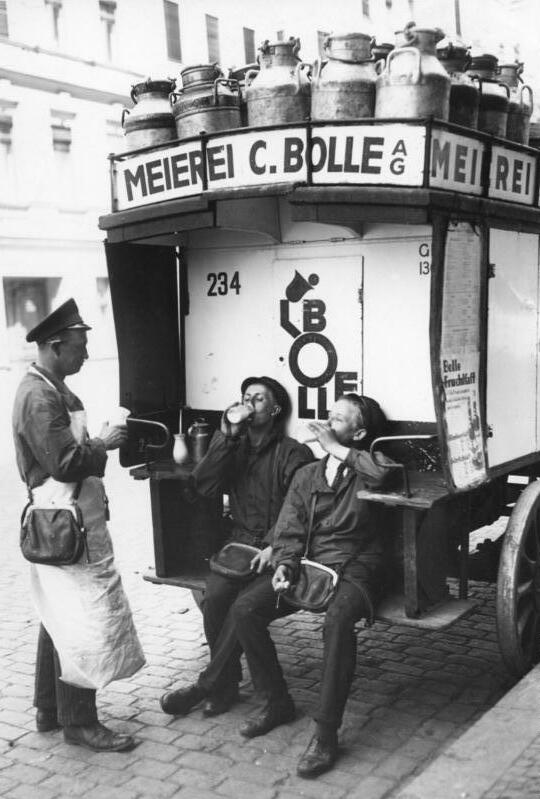
Drinking milk in Germany in 1932
The growth in urban population, coupled with the expansion of the railway network in the mid-19th century, brought about a revolution in milk production and supply.
Individual railway firms began transporting milk from rural areas to London from the 1840s and 1850s.
Possibly the first such instance was in 1846, when St Thomas's Hospital in Southwark contracted with milk suppliers outside London to ship milk by rail. The Great Western Railway was an early and enthusiastic adopter, and began to transport milk into London from Maidenhead in 1860, despite much criticism. By 1900, the company was transporting over 25 million gallons annually. The milk trade grew slowly through the 1860s, but went through a period of extensive, structural change in the 1870s and 1880s.
Urban demand began to grow, as consumer purchasing power increased and milk became regarded as a required daily commodity.
Over the last three decades of the 19th century, demand for milk in most parts of the country doubled, or in some cases, tripled.
Legislation in 1875 made the adulteration of milk illegal - this combined with a marketing campaign to change the image of milk. The proportion of rural imports by rail as a percentage of total milk consumption in London grew from under 5% in the 1860s to over 96% by the early 20th century. By that point, the supply system for milk was the most highly organized and integrated of any food product.
The first glass bottle packaging for milk was used in the 1870s.
The first company to do so may have been the New York Dairy Company in 1877.
The Express Dairy Company in England began glass bottle production in 1880. In 1884, Hervey Thatcher, an American inventor from New York, invented a glass milk bottle, called 'Thatcher's Common Sense Milk Jar', which was sealed with a waxed paper disk. Later, in 1932, plastic-coated paper milk cartons were introduced commercially.
In 1863, French chemist and biologist Louis Pasteur invented pasteurization, a method of killing harmful bacteria in beverages and food products. He developed this method while on summer vacation in Arbois, to remedy the frequent acidity of the local wines. He found out experimentally that it is sufficient to heat a young wine to only about 50–60 °C (122–140 °F) for a brief time to kill the microbes, and that the wine could be nevertheless properly aged without sacrificing the final quality. In honor of Pasteur, the process became known as "pasteurization". Pasteurization was originally used as a way of preventing wine and beer from souring. Commercial pasteurizing equipment was produced in Germany in the 1880s, and producers adopted the process in Copenhagen and Stockholm by 1885.
Overproduction
Continued improvements in the efficiency of milk production led to a worldwide glut of milk by 2016.
Russia and China became self-sufficient and stopped importing milk.
Canada has tried to restrict milk production by forcing new farmers/increased capacity to "buy in" at CN$24,000 per cow.
Importing milk is prohibited.
The European Union theoretically stopped subsidizing dairy farming in 2015.
Direct subsidies were replaced by "environmental incentives" which results in the government buying milk when the price falls to €200 per 1,000 litres (220 imp gal; 260 US gal).
The United States has a voluntary insurance program that pays farmers depending upon the price of milk and the cost of feed.
